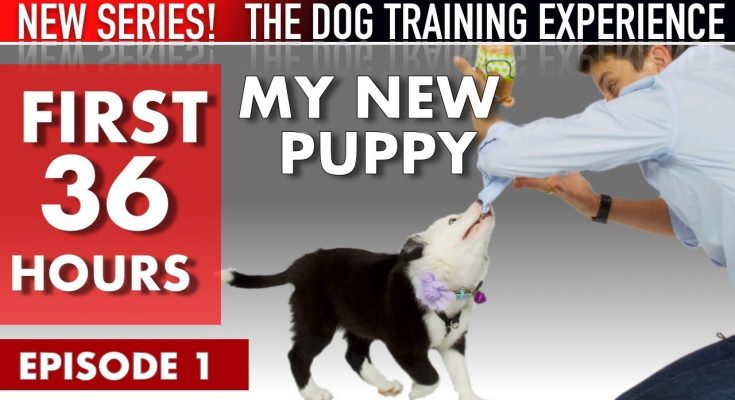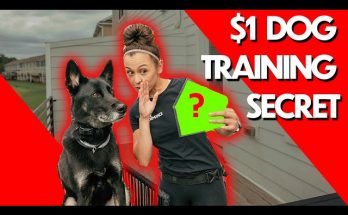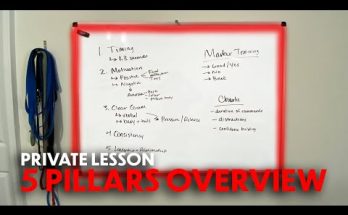Welcome to my new series, “The Dog Training Experience”! In the premier episode, you’ll see what my experience is like in the first 36 hours with my puppy. How to handle crying at night, potty training, socialization, clicker training and much more! Join me as I show you how I train my new dog everything! Thanks for sponsoring the first episode of The Dog Training Experience PupBox! Go to https://www.pupbox.com/zak and enter discount code "ZAK" to get 50% off of your first PupBox when you sign up for a multi-month subscription!
If you want the full experience, follow @zakgeorge on Instagram. I show you Inertia’s progress in realtime as well as do live training and answer your questions: http://www.instagram.com/ZakGeorge
Are you new to this series? Get caught up with all of “The Dog Training Experience” videos here: https://www.youtube.com/playlist?list=PLMssKIjsDxXl_ZXQgcHlEY_fC-yL5P76N
Like me on Facebook! http://www.facebook.com/TheZakGeorge
Support my videos by making a contribution on patreon: http://www.patreon.com/zakgeorge
Order the NEW book here: https://amzn.to/2XiER6f
Get my first book here: https://amzn.to/1PXH568





😁👍Thank you for the feedback everyone! I’m glad you’re enjoying! It only gets better from here! 🕺🏼Episode 2 comes out next Sunday July 28th, and episode 3 Comes out next Wednesday July 31st! 2 episodes in 1 week! I’ve had Inertia for 4 weeks now! We have been posting (and will continue to) realtime updates on instagram and have been doing a lot of live training too! http://instagram.com/zakgeorge🤗🤗😁
@Nic Bommarito I have 2 of them
@sierra hernandez try and get out as much as you can with the dog, but of course be safe! maybe they socializing with friends and family
}}}}} p}} pp} p} p}}}}} p}}}}}} p} p0} 0p0p0p000p0p0p0p0p0p0}0p0p0p00p0p00p0pp0p0}00p0p0000p0p}}0000p0p0p0pp00p0p0p0p00000p0p0p0p000p0p0p0000p0p0p0p0p0p0p000p0p0p0p000p0p00p0000p0p0p
000
I’m getting a dog in a couple of weeks! I’m so excited and you have helped me so much!!! 😀
We are picking up our Samoyed puppy this Thursday so this series is the best thing on the best moment for us! ❤️ Thanks Zak!
Hi
I LOVE SAMOYEDS <3
You’re so lucky to get a Samoyed! I wanted one but I’m getting a frenchie instead which is still great but I want a fluffy puppy 🐶
%90 of people watching are only watching this because they either want a puppy or are getting one, me included 😂
I’m getting one
That was my reason 💀
@Kayla Jackson yes PROGRESS
im getting one probably some time in 2022
Getting one 😀
Zac, she can’t be your dog! Bill Nye said Inertia was property of Matter. Lol
You mean mechanical engineer, Bill nye? He should stay in his lane…
Bill bye is not a scientist but he is a drug dealer 😅edit:bill nye sorry
This was the best comment ever seen 😂
🤣😂
@Cam WRONG!!! Bill is a trained mechanical engineer. He graduated from Cornell University (in ’73) then worked at Boing, Seattle, as a MECHANICAL ENGINEER. And, for for your information, a mechanical engineer IS a scientist! Before you make stupid statements and spread lies, check your facts. It’s a real easy thing to do. Easier than learning how to start names with capital letters.
It would be really cool if you made an info graphic, maybe a worksheet, or even a to do list with tips of things to do within the first 36 hours.
Tesla Cannon yesssss!!!
My 12 week old chihuahua can now sit, lay down, roll over and stay because of you ❤ hes sooooo willing to learn, I love it. Thankyou 🙏
Inertia: *fast asleep
Zak: We’ll make this a training moment
Zak: *touches a sleeping Inertia’s paws
People are going to think im crazy wearing a fanny pack with treats and a clicker on my wrist but i will have the goodest doggo!
Whenever I see people wearing a fanny pack with a dog I assume they are a responsible dog owner (especially when I see there’s a plastic bag in it)
If it’s full of treats I assume he or she is training a dog.
But when a person walking around with a fanny pack without a dog ….
I obviously won’t put them on my fashion role model list.
I am just getting a dog next week and I JUST GOT A FANNY PACK!
why care about what people think ? kids…..
@AwesomeGaming101 you said this for a very long time ago but we use them to tell our dog that they are doing some thing that we like I think
Dog: *blinks*
Zac: That’s a magical moment.
Thats what every dog owner feels
Lol
Inertia: blinks*
Zak: “See that reaction? That was so interesting”
Ye
Haha 😂
But she perked right up
Who else is here, about to get a puppy during the pandemic? 😭😢😭😭😭😭😭 Gonna need to socialize him somehow………
@Bibs Roast no dont get one of those
On the deposit list, about a 12 month wait right now, can hardly wait for another border collie
I’m getting a Bernedoodle puppy soon!
Don’t abandon your dogs after cuz lots of ppl buy it bc they’re sad but after they don’t care for it so don’t do that
@Lamb sauce loop play q
I’m getting a golden doodle in about month so I’m binging all these during the pandemic
My doodle had a puppy and we’re starting to train her now
Do you like the goldendoodle? We are looking at getting one, who was the breeder? Sorry about all the questions!
Maddie Weiler I’m getting a miniature Australian Shepard mix with a shih zu
@John Curt they are good dogs, they have the sweetness of goldens and the intelligence of poodles
same im getting a labradoodle in may
I get why she’s called inertia. “A puppy at rest remains at rest”
lol!
Lisa Gallegos – Dog Training ooh ur a dog trainer too
@Lisa Gallegos – Dog Training ancient person
Inertia : performs cellular respiration or any other function essential for survival
Zak : “let’s go ahead and make this into a training moment”
The Summary Girl:
Dog Training Experience – Ep. 1
Steps:
1. Pick up puppy (at 8 weeks from your reputable breeder)
2. Go to the vet ( to make sure your puppy is healthy) Tip – Use treats to get your puppy comfortable and make a positive association with the vet (and new places).
3. Condition your new puppy to things like the clicker, collars and harnesses + Stay in town for an extra day (if your breeder lived far away). Tip – Take things slowly, there’s no rush. Go at your puppy’s speed and comfortability.
4. Have your PupBox ready to do a bit of training or have your puppy supplies ready to do some training (make sure you have your wipes, pee pads, treats toys and a clicker).
5. Do a bit of clicker training. (Teach your puppy that the clicking sound means they will get a reward). Tip – Keep treat small. Keep training sessions short, frequent and reward for the slightest positive actions.
Remember! – The click does not tell your dog to do something, it only communicates that you like what the did.
6. Get their collar and harness on so you can make sure that they don’t get into any trouble. Tip – Reward with treats for little progress so your puppy is comfortable with their harness and collar. This also builds positive association.
Remember! – Take it Slow. This builds trust between you and your puppy which is fundamental in training and your overall relationship.
Remember! – Too much freedom to early is the biggest mistake people make. Have them comfortable leash for their safety and your benefit.
7. Play with your puppy, to build the bond between you. This is essential for training and trust. It is also great for your puppies brain development.
8. Give them plenty of time to nap because 8 week old puppies need 18-20 hours of sleep per day.
9. Give them plenty of opportunities to relieve themselves. Better safe than sorry 🙂
10. Condition them to sleeping at night, and relaxing in anxious situations.
11. Travel back home the next day.
12. Have plenty of breaks for your puppy to get some energy out and pee. However, avoid over dogs or areas where other dogs visit frequently to avoid your puppy getting ill if they have got all their vaccines.
13. Arrive home and do the feed them etc.
14. Watch the next episode of The Dog Training Revolution, Subscribe to Zak George, sign up to PupBox and buy his books on dog training for more information about raising your puppy.
Desensitization:
Touch desensitization –
1. Try and get your pup comfortable with your touching their ears, paws, tail etc. so that they are more comfortable at vet checks or other occasions where they get touched in those areas. A road trip home is the perfect time to do this kind of training.
Sound Desensitization –
1. Make sure your puppy is well socialised.
2. When your puppy sleeps walk around, speak loud, open doors etc. The purpose of desensitization is to make your dog/puppy more accustom to loud noises meaning they will no freak out when something loud or abrupt happens. Note – Do not overwhelm your dog or puppy because this does more harm then good. Take it slowly. Use positive reinforcement for good behaviour (staying calm, not barking). Make sure you are attentive to their body language so you can prevent negative reactions before they happen. However, there is no reward necessary if they are just naturally relaxed.
Remember! – Expose them to a variety of sounds both artificial and natural over the sound desnsitization process.
Crate Introduction:
Why use a crate?
A crate is used to easily control your dog’s environment for short periods of time if you cannot directly tend to them.
1. You can either gently place your puppy in the crate while there sleeping with the crate door open or toss in some treats and encourage your puppy to go in and out of the crate at their own free will.
Remember! – This is to build up a positive association with the crate. Do not force your puppy inside and close the door or they will build a negative association with it. Take is slowly.
2. Allow them to sleep in the crate ( but only when they have fallen asleep by themselves and you put them in their crate).Note – Your puppy will wake up frequently at night and may whine. Feed them if they may be hungry as well as allow them to relieve themselves. Use it as an opportunity to do a bit of clicker training. When they even have a split second of silence click and reward right away so they make the connection between them being silent and the reward.
3. Encourage them to relax if they have a bit of anxiety. That is part of the training, desensitization and transition process for your new puppy. They are not used to things so it is normal for them to whine or be anxious at night. So be prepared and help them to remain calm. Pay attention to their body language so that you can prevent any negative habits or behaviours from forming. Reward for silence/relaxation and do not give the opportunity for them to whine by rewarding frequently. Be patient. They will get better. But also have empathy for them, its ok to comfort them if they are very anxious or get on the floor and sleep so your closer to them.
Remember! – Use positive based training and reinforcement for good behaviour. Never shout at your puppy even if you’re frustrated or that will make them even more anxious. Stay calm.
Training:
House Training –
1. After your puppy has taken a nap in their crate take them over to a pee pad or outside if it is close. However, make sure you have a indoor option as puppies will immediately want to pee after they wake up. Tip – Having them on a leash and harness will allow you to keep them on the pad.
General Training –
1. You can jump into another short training session with your puppy (e.g “Look at Me” training”) using the clicker. Note – Make sure to keep sessions short and frequent, only using positive based training.
Remember – Dogs are learning at every moment!
2. When doing “Look at Me” training make sure to click and give the reward to communicate that you liked what they did. You can also say their name so they equate their name with looking at you.
3. You can also work on “Leave It” training when you take them outside, You can use the clicker for this too.
Remember! – Keep training sessions short and reward for listening/good behaviour.
Socialization:
1. Primary socialization is very important for your puppy. Take your dog out to new places and to see new people. This all part of the training and desensitization process. Note – Your puppy can get overwhelmed or anxious by too many people so pay attention to their body language. If they do start to get anxious give them a break.
Play:
1. Playing with you puppy is good for bonding and mental stimulation. It also helps to get their energy out so they don’t use it for something destructive. You can introduce them to fetch (tossing the toy the toy back and forth) and getting some mild exercise done (play). Remember! – Be really animated with you puppy to get them excited. They feed of your energy and it strengthens the bond.
How to teach “Let Go”?
Hold the toy still and make it boring. That way they will lose interest. When they let go make sure to say a “Yes” or use the clicker to communicate that they did something right then toss it again for them.
Playing outdoors:
Until your puppy/dog is fully vaccinated, do your best to avoid areas that are likely frequented by other dogs.
Tip – Wipe your puppy’s paws of with dog wipes after they have been outside so you can avoid them getting ill.
1 like = *1 more training moment* :3
We o
Thank you for this!
Or
1like: One prayer for those fingers. That must of taken AGES. And for strangers- *Queen*
Great Information!!!!
I wonder how long it took for you to type all of this. Lol i
“You just keep growing, stop growing.” All puppy owners felt that
literally
I know mu dog won’t stop growing
… i said this?
@CuddlyBubbles 69 yesir
When you don’t have a dog but you want to be prepared when you get one
Me there is a 50% chance i get one in like may and I’m researching A LOT
i will get one aroud june or july
Ok hear me out, imagine him in a traffic dram ‘all it takes is a little patience and you’ll get there fine’ *car moves a centimetre* ‘YES! you see that is the reaction we’re looking for!
“your like a leaky water balloon, you pee so much”😭
Zak thinking: This place looks like an area that dogs don’t frequent
Almost all other puppy owners thinking the same thing